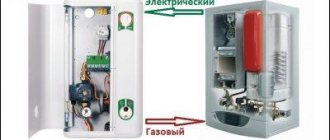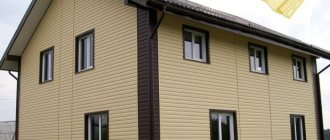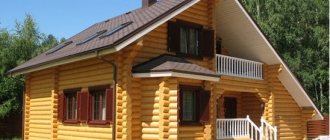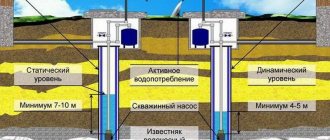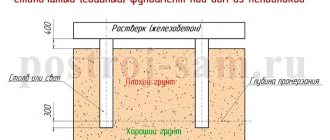The heating system in a private house, as a rule, comes in two types - with natural and forced circulation. If in the first case water moves due to thermal expansion, then during forced circulation the coolant is pushed into the pipeline by the impellers of electric pumps, and for efficient operation, the correct selection of a circulation pump for the heating system is important.
The task of selecting a suitable model includes choosing its operating principle and calculating the main parameters - the volume of pumped coolant and pressure (supply height). You can carry out the necessary calculations yourself using formulas, tables or online calculators - for this you need to know what initial data to enter and how to make the calculations correctly.
Fig. 1 Circulation pumps for a private house in operation
Content
There are two circulation systems - classical and forced.
In the first case, the heating system device must contain a vertical pipeline in its design, where natural circulation of water occurs under pressure. In the second option, circulator pumps are used, which forcibly produce regular circulation of water. Such pumps are included in the design of most modern heating systems, and their presence guarantees the maintenance of uniform temperature in the room over its entire area.
How to choose a suitable circulator pump for a heating system and what should you pay attention to first?
When operating the heating system, it is necessary to use coolant circulation
How to choose a circulation pump for a heating system according to its characteristics
To calculate the technical data of the unit, we need knowledge of several parameters.
Heating pump type NO 25/6.
The volume of coolant of a certain temperature that must be pumped per unit time through the lines of the circuit or heating circuits - that is, the thermal power of the pump. This parameter is influenced by the building material from which the house is built, the characteristics of the boiler, and the design of the system. However, for an approximate calculation, you can take the standard value - 100 W per meter of heated room. The formula for calculation will look like this:
G = Q/(1.16 x D)
where Q is the required amount of heat in watts, “1.16” is the heat capacity of water, D is the difference in coolant temperature at the inlet and outlet of the heating circuit. For standard heating systems using radiators this value is 20 degrees, for “low” convectors – 10, and for “warm floor” systems – 5.
The result calculated using this formula will be in kg/hour. Considering that the pumps’ data sheets indicate their productivity in cubic meters per hour, this figure will need to be recalculated. The resulting number must be divided by the density of water or other coolant at its average temperature.
For example. To heat a room of 100 m², with standard heating appliances and a water temperature of 70°C, you will need a pump with a capacity of about 0.44 m3/hour.
Working conditions. This includes the resistance of the heating circuit lines with all bends, fittings, shut-off valves and other elements, the parameters of the coolant - its density and temperature. All this is necessary to select a circulation pump for a heating system based on the pressure generated.
Heating pump type NO 25/4.
The calculation is made using a complex formula, which requires the certified resistance values of each valve, valve or fitting. It happens that manufacturers simply do not indicate this data. But usually it is enough to make a simplified calculation using the following formula:
H=RxLxZ
Where:
- R – resistance to fluid flow of a straight pipe (0.015 atm per meter);
- L – length of heating circuit lines;
- Z is a coefficient that takes into account all bends, shut-off valves and fittings - it is usually taken equal to 1.3.
After calculating using this formula, for the same room of 100 m², we will need a pump capable of creating a pressure of about 0.9 atm. However, it is recommended to select a circulation pump that has at least 10% power reserve. Therefore, in our version, a pump with a capacity of 0.5 m3/hour with a pressure of 1 atm is suitable.
Circulation pump PRORAB 8860.
Manufacturers and prices
Heating is the main system of a private home; unlike water supply and sewerage, its stop can cause significant financial damage if it breaks down in winter and defrosts. Even if the owners are present in the house and the circular device is out of order, you will have to urgently buy a new device, and this is not always possible in remote rural areas. Also, high-quality pumping equipment for heating increases living comfort and saves energy resources - so it is better to choose models from well-known manufacturers, avoiding the Chinese counterfeits described above.
Wilo is a well-known German manufacturer that supplies the market with a wide range of household circular saws of the RS, Stratos, Smart, Top series, all modifications have the following features:
- Manufactured in accordance with the European energy saving directive EnEV for heating circuits with a thermal power of more than 25 kW, according to which only automatic control of the operation of pumping equipment and the presence of at least 3 stages of regulation of electricity consumption are allowed.
- Designed for European AC voltage of 230/400 V with a tolerance of 10%.
- The housings are mainly made of cast iron.
- The power of the units, depending on the pressure and volumetric characteristics, ranges from 40 to 200 watts; the previously selected electric pump for a one-inch pipe Wilo - Star RS 25\6 has a power of 99 watts.
- The cost of Wilo circular electric pumps ranges from 50 to 100 USD.
Rice. 14. Selection of a circulation pump for a heating system from popular brands Grundfos, Wilo, DAB
Grundfos is a world-famous Danish manufacturer of pumping equipment; the market offers models UP, UPS, UPSD, Solar and their more modern analogues Alpha2, which have the following features:
- The cases are made of cast iron, brass and stainless steel (marked with the letter N).
- UPS models are equipped with 3 shaft rotation speeds; in Alpha2 the frequency is automatically adjusted.
- There is a wide range of powerful models with a supply volume of up to 15 m3/cu.m. and pressure up to 15 m.
- The cost of Grundfos electric pumps is 70 - 100 USD, the price of powerful devices can reach up to 500 USD.
If we compare the power of Wilo and Grundfos units, then the Grundfos UPS 25-60 180, similar to the previously reviewed Star RS 25\6 device from Wilo, consumes one and a half times less electricity - its power is 60 W. In addition, Grundfos has a maximum supply volume of 4.35 m3/h. versus 3.5 m.cub./h. at Wilo.
DAB is a well-known Italian manufacturer that supplies the market with household circular pumps of the A and VA series, their distinctive features:
- Single-phase models have 3 rotation speeds and built-in overload protection.
- The operating temperature of the coolant is from -10 to +110 C.
- For domestic use, the VA line is most suitable, the maximum productivity of which is 3.5 cubic meters per hour and the maximum pressure is 6.5 m (for the A series, the corresponding maximum values are 16 cubic meters per hour and 11 m.) .
The choice of DAB models is the best option in terms of price and quality ratio, the DAB VA 35/180 circular machine with a maximum productivity of 3 m3/h. and a head of 4.3 m costs about 60 USD. - this is for 40 USD cheaper than Grundfos and Wilo.
Rice. 15 DAB options
Wilo
The history of the German manufacturer Wilo dates back to 1872.
Despite the turmoil with the owners, the main line of activity - pump-action equipment in various modifications - has not changed to this day. With the development of technical progress, this branch has grown to large-scale production of climate control equipment. On the Russian market, Wilo products are represented by its own network of sales offices. Servicing is carried out by our own and authorized workshops, ensuring stable operation of the equipment sold for a sufficiently long period. A clear example of active activity is the comprehensive proposals for heating systems installed since 2015. For which the manufacturer provides 4 years of official warranty. Some Wilo models
| Model | Pressure, m / volume, m³/h | Power by operating modes, W | t coolant, C | t environment, C | Installation method / pipe diameter, (inch) | Serviced circuit, m | price, rub. |
| Yonos PICO 15/1-4 | 10 / 2.7 | 4…20 | -10…+110 | 0…+40 | Thread / 1 | 160 | 6051 |
| Wilo Star-RS 25/4 | 4 / 3 | 28-38-48 | Thread /1½ | 66 | 4664 | ||
| Yonos MAXO 50/0.5-12 | 31 / 12.8 | 15…600 | Combination flanges PN6/10 | 510 | 45573 |
Watch a video about the history and modern production of Wilo:
Selection issues
For a specific facility, the heating pump is selected taking into account the hydraulic characteristics of the system. Naturally, the system parameters are calculated by specialists in advance based on:
- climatic conditions of the region
- degree of building insulation
- thermal insulation properties of floor and ceiling
- sealing windows, doors, etc.
The result of such calculations is the determination of the volume and temperature of the coolant that should be regularly supplied to the room. The value is expressed in cubic meters per hour and is a key component of pump productivity. In addition, its pressure must prevail over the hydraulic resistance of the system.
When choosing a specific model, it is advisable to ensure that its technical characteristics are slightly lower than the maximum required. The device will not experience any special overloads, but idle operation can be avoided. In addition, devices that are not fully loaded create unwanted noise in the heating mains.
How to choose a heating pump
To make the right decision, the selection of a circulation pump must take into account the following requirements and rules:
- The unit must fully comply with the received power calculations. You need to calculate the performance in advance or ask the heating adjuster about it. Under no circumstances should you buy a product at random.
- In order for the pump to produce the pressure declared by the manufacturer, you need to select a device based on your pipe diameter. The larger the diameter, the more powerful it is worth buying the device.
- It is worth taking into account external weather conditions. If the pumping station is located in a separate room, then there is a high probability that the unit will freeze.
Types of circulation pumps for heating systems
Manufacturers offer equipment with different designs that determine the order of its operation and maintenance. We invite you to get acquainted with existing species and their distinctive features.
Not only the size is important, but also the design features
Dry pumps
The name of the equipment is dictated by its design features. The coolant is in contact only with the impeller. The rotor is located in a sealed housing, into which liquid does not enter due to the installation of several o-rings. Circulation pumps of this type have a fairly high efficiency, reaching 80%. They require regular maintenance, since the solid particles contained in the coolant negatively affect the sealing rings, causing depressurization of the rotor housing.
Dry pumps have high efficiency
On average, “dry” pumps can last about 3 years. During operation, they make quite a lot of noise, which can create some inconvenience during operation. That is why they are practically not used in the heating system of a private home. However, in large networks their installation is completely justified economically.
Can be:
- horizontal;
- vertical;
- block.
The pump type is selected individually
Circulation pump with wet rotor
In devices of this type, the coolant is in contact with both the impeller and the rotor. The metal sealed glass contains only the electrical part along with the starter. The efficiency of a circulation pump with a “wet” rotor is about 50%. Such equipment does not require regular maintenance.
During operation they make virtually no noise, which makes them the best option for a private house or apartment.
A pump with a “wet” rotor makes virtually no noise
Purpose of the pump for heating
Previously, circulation pumps were used only in centralized heating systems, and for private housing construction the natural movement of the coolant caused by temperature differences was the norm.
Now forced circulation is used everywhere thanks to the emergence of compact and inexpensive models designed to service the heating networks of small houses and cottages.
With the advent of circulation pumps, the number of circuit solutions has expanded. It became possible to lay long highways of varying complexity, while the dependence on slope practically disappeared
Due to the increase in the speed of movement of the coolant in the pipeline, thermal energy flows faster to the heating radiators, and accordingly, the rooms are warmed up faster. The load on the boiler has decreased because the water is also heated faster.
The need to install bulky and inconvenient large-diameter pipelines has disappeared; contours have become easier to camouflage under floor coverings or be buried in walls.
It has become possible to install a “warm floor” system on any floor of a private house, which operates effectively only at a certain pressure in the network
The main disadvantage of pumps for heating systems is their dependence on electricity. If the power supply is intermittent or there is a risk of a complete power outage for some period, it is necessary to install a backup power generator or at least an uninterruptible power supply.
The remaining disadvantages relate to the designs and functionality of various types of devices. For example, monoblock units and devices with a dry rotor are noisier and require constant maintenance, while a pump with a wet rotor is demanding on the quality of the coolant and has a pressure limitation.
Installation rules
The unit installation diagram can be found in the instructions. If the user installs the pump independently, then you should first study the manufacturer’s recommendations. Most often they relate to the following points:
- Installation of a closed heating system should only be carried out if there is a backup power supply. At the same time, its battery life should be at least 4 to 6 hours.
- If a single or two-pipe heating system is used, then it is necessary to install a bypass. This is especially true for regions with frequent power outages.
- It is strictly prohibited to turn on the pump in a system without coolant. To check the functionality of the heating, the water circuit must be filled with liquid.
- The instructions indicate the diameter of the pipes that should be used in the heating system.
- It is necessary to install a coarse water filter in front of the unit.
The choice of pumping equipment for a heating system must be approached with full responsibility. You should not save on a pump by purchasing products from unknown brands at a low cost.
Requirements for installation of a circulation pump
There are a number of standards that regulate at the legislative level the installation of a circulation pump in a heating system. Some of the rules are set out in SNiP 2.04.05 “Heating...”. For example, it talks about the priority of schemes with forced circulation in heating networks.
Almost all requirements are justified by the operating efficiency of the system as a whole and the circulation device in particular. For example, the shaft of a device with a wet rotor must be installed on the pipe strictly horizontally in level so that there are no air pockets inside and the pump parts do not wear out prematurely.
A mandatory element of the system is an expansion tank that compensates for changes in the volume of coolant during heating/cooling. Its place in a closed system is on the return line, in front of the circulation pump
A filter for dirt and abrasive particles is needed in any case, even when installing monolithic models. Filtered coolant will cause much less damage to pump parts than liquid with sand and suspended matter.
The mudguard is installed with the plug down in the direction of water movement to reduce resistance and facilitate system maintenance.
Some rules are dictated by manufacturers. For example, it was customary to install old models of certain brands exclusively on the return line, since they could not withstand high temperatures.
Now pumps have become more versatile and can be installed in any suitable location, but subject to power parameters.
Where is a circulation pump used for heating a private home?
Heating systems come in two types: natural and forced circulation. The first type is relevant for houses whose square footage does not exceed 100 m². With a larger area, uniform heating of all radiators is impossible. The coolant will move poorly through the pipeline, which will inevitably cause large heat losses.
The circulation pump, which is part of the heating system of the second type, ensures the movement of the coolant through the heating system at a certain speed. During the installation process, there is no need to control the slope of pipes, which may have a smaller diameter. Thanks to the forced circulation, it is possible to ensure uniform heating of various points of the heating circuit, and, as a result, of all rooms, regardless of their location relative to the boiler. The circulation pump for domestic hot water allows you to maintain water pressure at a given level.
The circulation pump ensures a stable flow rate of the coolant
Features of a modern heating system for a country house
Depending on the region, the heating season in our country lasts on average 6-7 months. Because Energy prices are rising all the time, and among owners of country cottages there is increasing interest in building energy-efficient houses, i.e. buildings where all energy losses are minimized. Practice shows that with a competent approach to the process of constructing such a house (based on thermal engineering calculations), the funds spent on its construction are returned in the form of reduced energy costs.
But often one important point is overlooked - the construction of an energy-efficient, and therefore economical, house requires solving a whole range of problems. In addition to insulation and installation of a ventilation system with a recuperator, to minimize costs it is necessary to increase the efficiency of the heating system.
The heating “engineer” of a country cottage includes a wide variety of equipment. These are solid fuel, gas, electric or diesel boilers, underfloor heating systems or wall radiators with thermostatic heads, etc. Therefore, the heating system of a country house is equipped with circulation pumps.
A circulation pump is needed to pump coolant through a long-distance heating circuit (pipelines).
Often, conventional (unregulated) circulation pumps are installed in the heating system, operating at a constant speed all the time or having stepwise adjustment of the coolant pressure in 2-3 ranges.
These pumps may have an outdated design and an inefficient motor. This leads to significant overspending of funds. To avoid this, the heating system can be upgraded by installing a “smart” circulation pump.
Calculation of circulation pump performance
Before choosing the desired circulation pump model, you should do the hydraulic calculation of the system. The operating performance of the pump is closely related to the thermal output of the heating system in question. Consequently, the volume of coolant pumped by such a unit must provide thermal energy to radiators in all rooms. Therefore, calculations will require the value of the thermal power required to heat the premises and the entire building.
As an example, we can use a private house with an area of 100 m2. The thermal power value will accordingly be within 10 kW. Next, the pump performance is calculated using the following formula: G = 3600Q/(c∆t), in which G is the required amount of coolant (kg/h), Q is the thermal power of the system (kW), c is the specific heat capacity of water, equal to 4.187 kJ/kg ºС,Δt – is the temperature difference in the supply and return pipes. For calculations, its temperature is taken to be 20 0 C. Thus, in accordance with the initial data, the performance of the circulation pump will be equal to: 3600 x 10 x 4.187 x 20 = 429.9 kg/h or in larger units - 0.43 t /h.
When choosing a pump, you will notice that the technical data sheet contains volume units instead of mass flow units. In this case, it is necessary to convert the mass of water into its volume using a density of 0.983 t/m3 at t = +60 0 C: 0.43/0.983 = 0.44 m3/h. The resulting value will be the calculated operating performance of the device.
What do pump characteristics mean and how to take them into account when selecting equipment
To select a pump, you need the following initial data:
- volume of pumped liquid;
- maximum media temperature;
- lift height or number of floors.
Ideally, the pump performance, expressed in liters per hour, is three times higher than the volume of coolant (water). If the performance is too high, the coolant will not have time to transfer heat to the room and the heating efficiency will be low.
The other extreme: the heating circulation pump has reduced performance. As a result, at the end of the stroke, the water temperature will be insufficient to effectively heat the rooms, and to compensate for this, the heating temperature in the boiler will have to be increased excessively.
In practice, you can use a simplified calculation, in which the boiler power in kW corresponds to the volume of water pumped in 1 minute. For example, for a 24 kW boiler, the optimal pumping speed is 24 l/min.
Circulation pumps for home heating systems are designed to work with hot water, but it is better to choose the model that has a higher maximum temperature.
The parameter “Maximum height of the water column” is relevant only for two-story heating. A typical value of 10 m is enough for a system to organize heating in a two-story house. And with single-story heating, a pressure height of 6 meters corresponds to 100 meters of heating pipes with a diameter of half an inch.
Modern circulation pumps have 2-3 operating modes with different pumping speeds. We recommend focusing on the average value, since at maximum power the pump makes more noise.
With dry or wet rotor
Which circulation pump is better to install for heating: with a “dry” or “wet” rotor? The answer will be given by considering the design and characteristics of each device. Pumps with a “dry” rotor are units in which only the impeller is located in the water. The rotor itself is separated from the water by sealing rings. Such devices have their pros and cons in terms of domestic use.
Advantages of “dry” pumps:
- High efficiency. The efficiency of such devices is 80 - 85%, which is much higher than that of devices with “wet” rotors. Due to their reduced energy consumption, they are advantageous for use in systems with a total pipeline length of over 200 m.
- Working with high temperatures. The temperature of the pumped liquids can be about 110 - 115°.
Disadvantages of “dry” pumps:
- High price. Such units themselves are quite expensive to purchase and maintain.
- Regular replacement of O-rings. On average, the service life of seals is about 3 years, after which they will have to be replaced. The more solid particles there are in the pumped liquid, the shorter the seals will last.
- High noise. Due to their design features, “dry” models are very noisy, so they will have to be placed in separate rooms (ideally) or in the basement.
It can be said that dry pumps are more suitable for industrial applications where it is necessary to create high pressure and pump liquids through a pipeline of several hundred meters. Some dacha owners install similar units for themselves, connecting the heating system of the house with a workshop, garage or outbuilding. However, if all your heating is less than 200 m, then “dry” models are not relevant for you.
In “wet” pumps, the rotor is in direct contact with water, so only horizontal installation is possible for them. All the filling is enclosed in a metal glass (body).
Advantages of “wet” pumps:
- Low cost. The cost of such units is significantly lower than that of “dry” ones.
- Does not require constant maintenance. Although these pumps can still fail for some reason, they do not require scheduled maintenance, such as “dry” ones, where the seals need to be changed regularly.
- Quiet at work. Due to the fact that the rotor is located in the coolant, its operation is quite quiet, so it will not wake up the apartment residents. It does not require a separate room.
Disadvantages of “wet” pumps:
Low efficiency. The efficiency of such devices is approximately 50 - 55%, so they are applicable only in small private households (pipeline up to 200 m long).
For a private home and cottage, it is best to use “wet” pumps, which are cheaper and easier to maintain. For most owners, low efficiency is not critical, since at home there is no need to create high pressure for high pressure. Also, water in heating pipes rarely reaches 90°C, and “wet” pumps allow you to work with coolants at temperatures of 90–100°C. If you have a house with an area of up to 150 m2, then this type of unit is suitable for you.
Other parameters influencing the choice of circulation pump
Coolant circulation speed. It is preferable to choose a model with several operating modes; this will increase the flexibility of adjusting modes (even manually) when the outside temperature changes. Another nuance is that the maximum flow rate of liquid circulating through pipelines and heating devices should not be more than 1.5-1.6 m/sec. This is the speed at which the heating system still operates silently.
Pipe diameter. Small diameter pipes place the maximum load on the pump. Accordingly, the equipment must be more reliable, and this also affects its cost. The brand is expensive.
Pressure characteristic. The passport for the unit contains a graph of the dependence of performance on pump pressure. You should choose a circulation pump where the calculated parameters are closer to the middle of this curve.
Heating pump type NO 25/4.
Coolant temperature and maximum pressure. It is better if the maximum operating temperature according to the passport is 110°C or higher. This guarantees normal operation in any system. As for pressure, in the heating circuits of houses and cottages it rarely exceeds 3-4 atm.
Electronic protection against overheating and dry running will also extend the service life. The latter is especially true for pumps of the second type - with a wet rotor.
The best circulation pumps for heating in terms of price-quality ratio
Pumps with good pressure and performance are capable of maintaining the required level of coolant circulation in a one- or two-story house. The following models have the optimal combination of affordable price and good technical parameters.
GILEKS Compasses 32-80
Rating: 4.9
The circulation pump JILEX Compass 32-80 has an excellent ratio of cost and technical characteristics. Thanks to a powerful electric motor (245 W), the pump creates a maximum pressure of up to 8 m, providing a throughput of 8 cubic meters. m/h. The model works perfectly in heating systems of private houses (up to 3 floors). The kit includes fastening nuts protected from corrosion. A three-speed switch allows you to save energy by choosing the optimal mode for your heating system. Experts gave the model first place in our rating.
Users have no particular complaints about the operation of the pump; it has the best price-quality ratio. The device operates reliably, silently and efficiently.
Advantages
- saving heat and electricity;
- high-quality assembly;
- silent operation;
- reliability.
Flaws
- not detected.
WCP 25-80G (180 mm)
Rating: 4.8
The WCP 25-80G (180 mm) pump is practically in no way inferior to the rating winner. It is suitable for installation in single-pipe or two-pipe heating systems. The model is equipped with a powerful motor (245 W), which provides performance from 0.5 to 8.5 cubic meters. m/h and pressure from 0.5 to 8.0 m. The pump is well made, the cast iron body and aluminum motor make the device durable. Thanks to the three-position control, users can choose the desired operating mode. The strengths of the pump include its compactness, which simplifies its installation.
Overall, homeowners are pleased with the pump's reliability, affordability, and durability. The product failed to surpass the leader in the rating due to loud noise at maximum speed and low-quality plastic.
Advantages
- compact dimensions;
- light weight;
- three-position regulator;
- affordable price.
Flaws
- noisy work.
Wilo Star-RS 25/4-180
Rating: 4.7
The German pump Wilo Star-RS 25/4-180 is popular among domestic homeowners. In just 2 months, 2187 people in the nuclear field were interested in this device. The model is designed for small heating systems. The device consumes only 48 W of electricity, delivering a maximum head of 4 m and a throughput of up to 3 cubic meters. m/h. The model looks reliable, the cast iron body and stainless steel shaft will ensure a long service life. The pump earned high marks from experts for its quiet operation and the presence of a speed switch.
Users praise the German device for its reliability, silent operation and low power consumption. The pump failed to rise higher in the rating due to limited performance and only horizontal installation.
Advantages
- reliability and durability;
- silent operation;
- economical energy consumption;
- affordable price.
Flaws
- modest performance.
DAB EVOTRON 40/180
Rating: 4.7
The Italian circulation pump DAB EVOTRON 40/180 is designed to work in air conditioning and heating systems. The manufacturer has used advanced electronic rotation speed control. Thanks to this, the pump's performance can change automatically, which has a positive effect on energy efficiency. Sleep mode allows you to save electricity. Experts note the presence of thermal insulation of the housing and minimal power consumption (27 W). The maximum head is 4 m, and the throughput is limited to 4 cubic meters. m/h.
Users are satisfied with the quality and reliability of the circulation pump, it is easy to use. The disadvantage of the device is the high price, due to which the model is located outside the rating pedestal.
Advantages
- quiet operation;
- automatic speed control;
- low power consumption;
- high-quality assembly.
Flaws
- high price.
Best models
The possibility of choice forces you to pay attention to equipment whose technical characteristics have been tested by time and many consumers. We invite you to get acquainted with the most popular models
Circulation pump GRUNDFOS ALPHA2 25-60 180
A high-quality model with high build quality. The circulation pump GRUNDFOS ALPHA2 25-60 180 is capable of operating in 7 modes. The connection is made using a plug. To increase the service life of the device, it is advisable to use an uninterruptible power supply. The advantages of the model include:
- wide range of power consumption;
- ease of connection and operation;
- intuitive control system.
The only drawback is the high cost
Grundfos Alpha2 25-60 180
Circulation pump Wilo Star-RS 25/4
A high-quality model with wide functionality. This pump is relevant for heating, water supply and ventilation systems. Long service life is ensured by a cast iron body and stainless steel shaft. Designed for pumping clean water. Installation only allowed in a horizontal position. The Wilo Star-RS 25/4 circulation pump has a capacity of 3 m³/hour. Works quietly.
The benefits include:
- high reliability;
- selection of operating speed.
Disadvantages include the requirement for a certain position during operation and the inconvenience of switching speeds.
Wilo Star-RS 25/4
Caliber NTs-15/6
A reliable three-speed model in a cast iron body from a budget series. Able to maintain performance at fairly high temperatures. Allows installation in various positions. With a power of 90 W, it weighs 2.5 kg and does not create noise during operation. Has a productivity of 2.5 m³/hour.
The advantages include:
- low cost;
- compact dimensions;
- durable body;
- good efficiency.
Among the shortcomings, it should be noted the low build quality, as well as the manufacture of individual rotor elements from plastic.
Caliber NTs-15/6
GILEX Compasses 25-40
Three-speed pump without gland seals. The use of special coolant ensures good lubrication and cooling of the engine. The circulation pump has low energy consumption. The power of the unit is 65 W. Creates a minimum of noise during operation. Capable of pumping up to 3 m³/hour. Thanks to its compact size, it can be easily installed in a heating system. Disadvantages include sensitivity to dirty water.
GILEX Compasses 25-40
UNIPUMP UPC 25-40
The best option for a country house. Has a power of 100 W. Economical equipment that creates virtually no noise when working in harsh conditions. It is easy to maintain. High-quality assembly guarantees a long service life. Disadvantages include sensitivity to external temperature.
UNIPUMP UPC 25-40
comparison table
The table shows the main characteristics and average price of circulation pumps, which will make it faster and easier to find a suitable model.
| Model | Power consumption, W | Throughput, cubic meters m/hour | Maximum head, m | Mounting length, mm | Average price, rub. |
| VORTEX CN-25-6 | 90 | 3 | 6 | 180 | 2 200 |
| UNIPUMP CP 25-60 180 | 93 | 3,18 | 2 200 | ||
| ELITECH NP 1216/9 | 105 | 1,38 | 9 | 160 | 3 900 |
| CALIBER NTs-25/8-180 | 165 | 9 | 8 | 180 | 3 100 |
| Aquario AC 159-160A | 120 | 1,56 | 9 | 160 | 5 200 |
| Wilo Star-RS 25/6-180 | 84 | 3,8 | 5,4 | 180 | 7 000 |
| JILEX Compass 32/80 | 245 | 12 | 8 | 6 800 | |
| Grundfos UPS 32-60 180 | 60 | 3,35 | 6 | 7 300 |
How to choose a circulation pump for heating a private house
The characteristics of any equipment are selected taking into account the conditions of its future operation. How to choose a pump for heating a private house? You can use reference tables that provide the necessary information depending on the square footage of the building. If this option does not suit you, it is worth performing a calculation that will allow you to obtain more accurate values.
Choosing a pump is quite difficult
Pump performance calculation
Pump performance can be calculated using the following formula:
G = M / ΔT × Ct, where:
- M is the power of the boiler that will be used to heat the house, W;
- ΔТ – temperature difference in the heating circuit;
- St – coefficient depending on the specific heat capacity of the coolant.
The boiler power can be found using the formula
Boiler power can be determined based on the fact that for each m² of a cottage or country house 100 W of power is required, for multi-apartment buildings - 70 W. If there is additional thermal insulation of the external walls, the power is obtained by multiplying 50 kW by the square footage of the house. For cold regions, the calculated value for private houses is increased to 175 W, for multi-storey houses - to 101 W.
When calculating the boiler power, heat loss is taken into account
If calculating the performance of a circulation pump seems too time-consuming, we suggest using a calculator. By selecting the required positions and entering the missing data, you can obtain the desired value.
Circulation pump performance calculator
Device pressure
This parameter determines whether the pump can overcome the force created by the hydraulic resistance of the heating system. If the vertical rise is compensated by the force created in the descending sections of the circuit, then pipes, valves, heat exchangers and other elements create significant resistance. This greatly complicates the calculation procedure.
The pressure of the circulation pump is determined by multiplying the length of the heating circuit by the resistivity of the pipe and a coefficient depending on the number of shut-off valves, thermostats and other elements of the system.
The device pressure must be sufficient
We invite our dear readers to use a calculator specially developed by our team.
Circulation pump pressure calculator
Calculation of the power of the circulation pump for the heating system
For a larger calculation of the circulation pump for a heating system, you can use the following formula:
N = Nk / DT, where
- N – desired value;
- Nк – power of the boiler used for heating the house;
- DT – temperature difference in the forward and return circuits. In most systems it does not exceed 15°C.
Power depends on the temperature difference between the forward and return circuits.
What else to pay attention to
When choosing a suitable model, you should also pay attention to the occupancy of the circulation pump. To periodically turn on the equipment in winter, an inexpensive model with low power is sufficient
In this case, the pump will perform an auxiliary function. If the pipeline is long without a circulation pump, the coolant will move slowly. Such a system will require a powerful model that allows continuous operation.
Manufacturers offer units whose design allows you to change the speed of their operation. In most cases, we are talking about three-stage adjustment. The user can select the optimal operating mode of the heating system depending on weather conditions. Some models have an automatic power control system.
When choosing, you should also pay attention to:
- maximum pressure in the system. In private homes it rarely exceeds 4 atm (under normal operating conditions - about 2 atm);
- body material. Cast iron is preferred. Products with a body made of heat-resistant plastic will cost less;
- connecting dimensions. An adapter may be required;
- presence and type of protection. Protection against overheating is especially important. With it, the service life of the pump increases significantly.
Frequency of inclusion is an important criterion when choosing
What is a heating pump
Heating designs with a natural whirlpool or recirculating supply can be quite effective, but only when serving small areas. For private houses and apartments with a large area, it is necessary to install a special device next to the boiler to force the movement of water through the system. A circulating pump is a technological device that operates in ring heating, continuously moving water through pipes. Its main task is to ensure continuous heat supply and water circulation in the system.
Circulation pump device
In a simplified version, the operating principle of such a technological device is based on the interaction of a motor and a rotor, which is immersed in a coolant. The motor provides a continuous supply of fluid, and the rotor helps convert kinetic energy into potential energy, thereby creating the required level of pressure in the system. However, in many ways, the high-quality and reliable operation of the circulation pump in the heating system depends on the type of device and its characteristics.
Kinds
Heating devices can be classified not only by brand name, but also by the characteristics and operating principle of the device. Thus, the types of circulating sediments are conventionally divided into only two types:
- A dry type ejector is characterized by the fact that the rotor part of the device does not come into contact with water. Such a heating pump at the output provides an efficiency of up to 85%, but creates a fair amount of noise, which is why it is preferable to install the device in separate gas boiler houses.
- Wet pumps are those devices in which the entire moving part is in constant contact with water. Warm liquid provides such technological devices with constant lubrication of parts and silent operation. The efficiency of circulation devices of the wet operating principle is only 50-65%, which is why it is preferable to install them in private homes.
Characteristics
To buy a circulation pump for heating, it is important to have a good understanding of its technical parameters. There are not too many characteristics that are worth focusing on. In fact, only two will be important for the common man:
- Pressure is the hydraulic resistance of the system. The value is measured in meters and, as a rule, is set by the value of the highest point of the pipeline.
- Productivity is a parameter showing how much liquid the device is capable of processing per unit of time. Productivity is measured in cubic meters per hour.
It is worth knowing that these concepts are inversely proportional. So the maximum power of the electric pump will be achieved at zero pipeline height, and the pressure at the same flow. Thanks to these basic characteristics, you can choose a model with optimal parameters for yourself. At the same time, the principle of choosing a device - the more productive, the better - is not suitable for achieving high performance. Purchasing the wrong unit will lead to a decrease in heat transfer and an increase in electricity consumption.
Marking
Before you finally select a pump for your heating system, you should familiarize yourself with and decipher the alphanumeric designations on the unit label. As a rule, the following characteristics are included in the marking of circulation pumps for heating systems:
- The letters UP indicate the type of unit. In this case, circulation.
- Then come the letters S/E, indicating the control method: step-by-step speed switching or smooth adjustment.
- After the letter characteristics come the numerical ones. The first block indicates the internal diameter in millimeters of narrow pipes, the second part indicates the maximum pressure in decimeters.
- The third numerical block is the millimeter value of the installation length. This indicator is important in case of insertion of the device.
- In addition, different manufacturers may indicate additional information on the label: type of housing material, method of connection to pipes, power or class of electricity consumption.
How to calculate the power of a circulation pump for heating
In order for the pump for circulating water in the system to fully meet the requirements, before purchasing it is necessary to calculate the power for the motor. If a unit is supplied with a performance index that is too high, the water in the pipes will make noise. Less power will not provide adequate heat. In fact, to correctly select a pumping device, it is necessary to calculate two quantities:
- engine performance;
- supply pressure.
The operating power will come from the total thermal output of the heating system. Simply put, the device must pump such a volume of liquid that it is enough to meet the needs of all radiators in the house. To calculate this, it is necessary to know the exact resource requirement for complete heating of the building. For private houses with an area of 100 square meters, this value will be 10 kW. The calculation itself should be made according to the following scheme X = 3600U (a * b), where:
- U – heat consumption for heating;
- A – thermal conductivity of water = 4.187 kJ/kg;
- B – temperature difference between the supply and return lines. As a rule, a value of 10-20 degrees is conventionally accepted.
Rules for installation in a heating system
In order for the water supply unit to serve for a long time and be convenient to maintain, a number of rules must be followed when inserting:
- For ease of dismantling, ball valves must be installed on both sides of the unit.
- To create a barrier to small mechanical particles, it is advisable to install a special filter in front of the device.
- It is advisable to install an automatic or manual air valve at the top of the bypass, which will remove accumulated oxygen from the system.
- Due to the fact that the installation of pumps in the heating system of different manufacturers has its own distinctive features, it is important to follow the installation direction indicated on the device body.
- It is always necessary to install the pump for water circulation in a wet-type heating system horizontally, so as not to damage the electric motor during operation. In this case, the terminals of the unit should always point clearly upward.
- Joints and threaded connections must be treated with sealants, and a gasket must be placed between the mating parts.
Types of circulation pumps and their design
Circulation pumps are usually divided according to the types of rotors used in them
- “Dry” (the motor in them is not immersed in the pumped liquid, and the stator is separated from the rotor by a sliding end seal);
- “Wet” (have a centrifugal wheel, always immersed in the pumped liquid, while the stator is separated from the rotor by a stainless steel plate).
The advantage of a device with a “dry” rotor is one, but important – it is a relatively high efficiency factor (efficiency), the size of which can reach 80%. It is also important to emphasize the point that for private heating systems, units with a “dry” rotor are used extremely rarely; they are mainly used in multi-storey buildings, industrial enterprises, office and commercial buildings and other facilities whose area exceeds 1000 m², although there may be and exceptions
Disadvantages of a circulation pump with a dry rotor:
- Very high noise level (up to 1000 dBl);
- Its installation is carried out in a separate isolated room for safe, uninterrupted operation;
- The need to control the presence of heavy dust particles in the coolant, as they destroy the sealing rings between the stator and rotor;
- High cost of service.
A circulation pump with a “dry rotor” and
a “wet” rotor has many more advantages, given its good characteristics:
- Minimal noise during operation;
- Maintenance - once a year (there is no need to monitor foreign particles in the coolant);
- Light weight;
- The repair is simple, as is the initial setup;
- Can be embedded into the heating system;
- Economical (depending on power, energy consumption ranges from 1.5 to 5 W per 1 hour);
- Light weight and compact.
Among the disadvantages are the low efficiency, which does not exceed 50%, and the need for a UPS for normal power supply from the network. It is for this reason that such devices are used in heating systems of a relatively short extent.
For heating a private home, this is the best option. On the other hand, if you plan to make several extensions to the house (garage, equipping the attic for a living room, auxiliary premises), then it is worth considering the issue and choosing a “circulator” with a “dry” rotor.
Pump devices with a “wet” rotor
What types of circulation pumps are there?
The pumps in the heating main are designed to move the coolant; their task is not to increase the pressure (booster pumps are installed for this), it is created only to overcome the hydraulic resistance.
The supply volume depends on the speed of movement of the liquid, and accordingly the speed of rotation of the impeller on the electric motor shaft.
Circular pipes belong to the In-Line type, in which the inlet and outlet pipes are located on the same line, and the nominal passage has the same cross-section along the entire length.
A distinctive feature of circular electric pumps is the dependence of the pressure on the design of the wheel blades on the electric motor shaft and the frequency of its revolutions, while all types are divided into two groups: with a frequency N of more than 1500 rpm. units are classified as high-speed; if the speed is less than 1500 rpm, they are called low-speed. By changing the power, you can regulate the flow Q, which is directly proportional to the rotation speed of the impeller N.
When operating the equipment, it should be taken into account that the change in power consumption P1\P2 is proportional to the square of the change in pressure H1\H2 and the cubic degree of the change in the rotation speed N1\N2 of the engine shaft.
When the rotation speed is doubled, the pressure increases 4 times, and the power consumption increases 8 times; the same proportion is maintained when the speed decreases.
Fig.4 Domestic circulation electric pumps for water supply and heating
It should be taken into account that low-speed types have a more complex design and a high price, which is fully compensated by the savings in electricity consumed by the electric drive when choosing this modification. If a unit is installed with stepless control of the rotation speed of the electric motor shaft depending on the temperature of the conductive body, then the energy savings will be even greater.
The optimal efficiency of electric pumps is obtained when its operating point is located in the middle third of the characteristics; for each brand, the manufacturer indicates the optimal parameter.
When choosing a circulation pump for heating, two main design options are considered - with a dry or wet rotor.
With dry rotor
In samples with a dry rotor, only the impeller on the electric motor shaft is immersed in the coolant flow, rotating on bearings that are separated from the rotor and stator of the motor by sliding mechanical seals. A high degree of sealing is created through the use of two tightly fitted ceramic and high-strength graphite spring-loaded rings, one of which rotates on the shaft and the other is statically fixed in the housing.
When rotating, a thin film of water is formed between the surfaces of the sealing washers, which acts as a lubricant and performs cooling functions. The devices are equipped with air-cooled electric motors; powerful samples have an impeller to supply air to the motor.
The efficiency of units with a dry rotor depends on the power and is 30% - 65% for devices with a power of up to 1500 W, 35% - 75% for modifications with a power of 1500 - 7500 W, and 40 - 80% for power models of 7500 - 45000 W .
Typically, the power indicator required for a household unit rarely exceeds 1500 W, while the maximum efficiency ceiling for equipment with a dry rotor is 65%.
Dry rotor circulation pumps are designed to supply liquid with high pressure; they are more often used in hot water supply (DHW) systems.
Fig. 5 Circular electric pump with a dry rotor for a heating system - structural device
With wet rotor
Models with a wet rotor are used only in closed heating circuits; they ensure rapid movement of liquid through pipes, which makes it possible to reduce the cross-section of the pipeline and reduce the amount of coolant in the system - these factors help reduce the overall costs of the heating system.
A relatively small amount of heat-conducting fluid increases the speed of response to changes in settings and facilitates adjustment.
In the design of the model, the rotor is separated from the stator by a thin-walled glass and rotates in liquid on bearings, which are lubricated and cooled by a coolant. The glass is usually made of non-magnetic stainless steel or carbon fiber, its wall thickness is 0.1 - 0.3 mm, the bearing material is pressed ceramic or sintered graphite alloy.
Electric pumps with a wet rotor do not have seals or cooling fiber - due to this they are characterized by silent operation. Their rotation speed is adjusted in steps manually or using automatic equipment in continuous mode, monitoring changes in pressure difference or temperature; if desired, the automatic system is configured to turn on the unit at a given time.
Modern devices are structurally built according to a modular principle, which facilitates their repair and operation; the models have a screw plug in the body to remove air when setting up the system.
Imported models of electric pumps and their parameters are designed to operate from a single-phase network with an alternating voltage of 230 V or from a three-phase network with a voltage of 400 V.
The efficiency of units with a wet rotor is lower than that of dry models due to the larger distance between the stator and the rotor, and as in all types, it increases with increasing power and overall dimensions of the unit. For modifications with a power of up to 100 watts, the efficiency is 5% - 25%, from 100 to 500 watts. - 20% - 40%, from 500 to 2500 W. - 30% - 40%.
It should be noted that at the highest power of an electric pump for a private home, about 1000 W, the efficiency of types with a dry and wet rotor differs by less than one and a half times.
This factor does not have a strong influence on the selection of a pump for the heating system due to the significant advantages of models with a wet rotor (silence, high throughput, small pipeline cross-section) over dry rotor units.
Fig.6 Glandless rotor pumps - design

